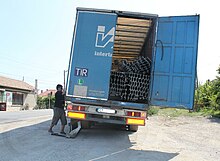Load shifting (freight transport)
A load shift in transport is understood to be an unwanted change of location of the cargo during transport. This is caused by the forces that can occur during transportation. In addition to the acceleration forces caused by braking, starting up and cornering, these can also be vibrations that arise during transport. In ship traffic, heavy seas are also considered, and in the case of the railroad, maneuvering over waste mountains. Inadequate, incorrect or inadequate load securing is always responsible for the shifting of loads . It can also be the case that the securing means are chafed through due to the lack of edge protection and can no longer fulfill their task.
By shifting the load, the center of gravity of the vehicle can be changed in such a way that it can even tip over. Furthermore, the boundaries of the vehicle can also be exceeded and, for example, oncoming traffic can be endangered. The shift can lead to cargo being lost. The shifting of cargo is often the reason for serious accidents that can lead to the sinking of a ship.
The most frequent cause is the wrong load distribution (longitudinally in the middle for items of equal weight), the poor securing (e.g. lashing down or failure to observe the load distribution plan).
Individual evidence
- ↑ https://www.yumpu.com/de/document/view/24759882/falsche-lastgabe-ladungssicherungde Cause of the accident Incorrect load distribution
